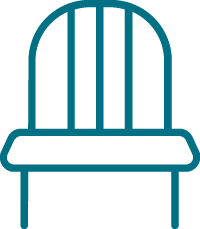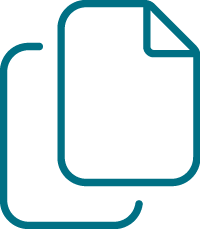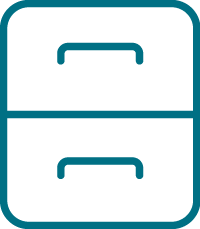by Jayme Radomski | Feb 7, 2023 | Clutter, Digital, Money & Paper Management, Organizing, Work & Home Office
Are you stressed by unmanaged paperwork around your home and office? Searching for important documents may seem hopeless. Interest charges and late fees can pile up quickly on misplaced bills. Deadlines are easily overlooked. Getting on top of your papers and developing a good paper management system will reduce stress. Here are some tips on how to get your paperwork organized, and regain control of your home and office.
Where you manage your paperwork should be convenient. Going to a secluded area of your home may not encourage you to manage your paperwork. If it is not an area you enjoy being in, you won’t go there.
The workspace should have ample surface area, basic office supplies (envelopes, pens, address labels), computer and printer, paper recycle bin and shredder.
Remove the
unnecessary, immediately
Sort your mail as soon as it comes in, with a recycle bin and shredder within an arm’s reach. Junk mail should be recycled immediately. Refer to a document retention guideline for guidance on what documents to keep and for how long.
Create a temporary, simple filing system for the initial sorting of your paperwork. This file system could include files labeled:
File – for files to be filed
Pay – for bills to be paid
To Do – for items that require attention within the next month
Read – for documents that will required your dedicated attention
Regularly go through and pay, sort and file
Set up a weekly time to go through the temporary files. Coordinate your bill paying with your pay dates. File papers from the ‘File’ file. Review your ‘To Do’ file for items needing attention within the next week. Take some time to read through the files from your ‘Read’ file.
It is important to always be aware of what papers, documents and receipts enter your home. Receipts can be sent via email or not retained at all. Be selective of what documents are collected at trade shows, conventions and seminars. Only accept the documents that are relevant to you. Be mindful of the mailing lists, marketing emails and promotional lists you sign up for.
Once your paperwork system is set up, plan to set aside time every week to maintain and manage your paperwork. Staying on top of your system will reduce stress and ensure you keep on top of your work and bills.
If setting up a paperwork management system is overwhelming, a professional organizer can help you started or guide you through the entire process. Top Shelf Home Organizing takes pride in working with people to organize and streamline their paperwork. Reach out to Jayme if you are ready to get your paperwork organized.
by Jayme | Feb 8, 2022 | Clutter, Cooking & Kitchen, Eating & Kitchen, Organizing
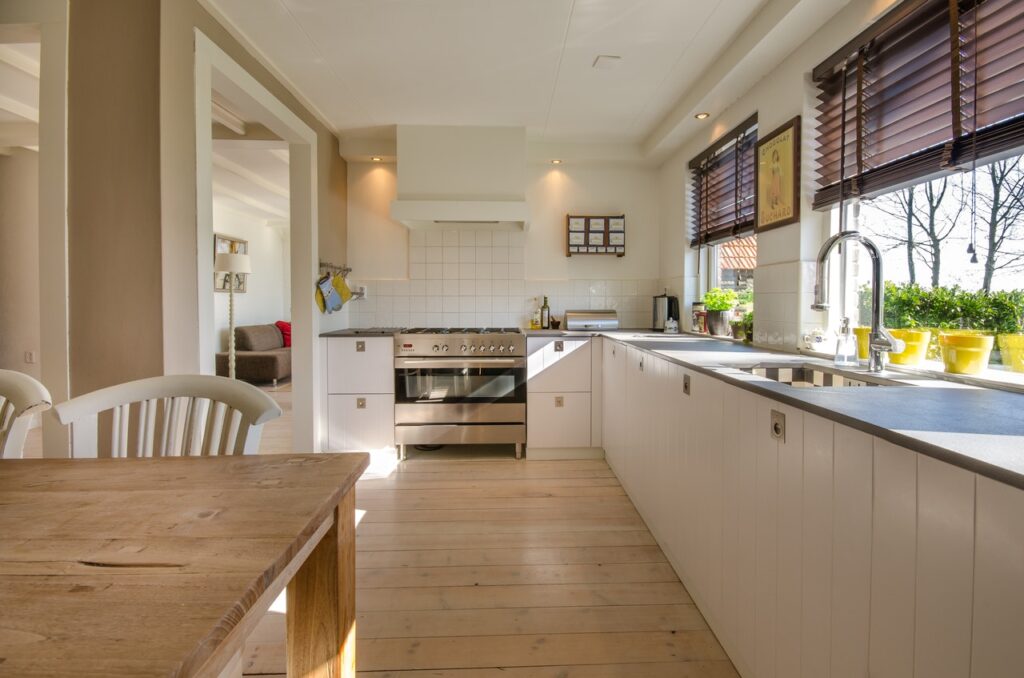 The new year is in full swing. Healthy eating and conscious kitchen choices are likely some of your new year’s goals. This month, we offer ideas on the 14 best areas to focus for decluttering and organizing your kitchen. Every day or two this month, declutter and organize your kitchen by breaking it down into small categories. You will feel a revised focus on your healthy eating goals.
The new year is in full swing. Healthy eating and conscious kitchen choices are likely some of your new year’s goals. This month, we offer ideas on the 14 best areas to focus for decluttering and organizing your kitchen. Every day or two this month, declutter and organize your kitchen by breaking it down into small categories. You will feel a revised focus on your healthy eating goals.
1. Baking dishes
Gather, sort, and evaluate all your dishes intended for baking. Simplify your inventory to the most practical items. Replace items that have lost their non-stick finish, are starting to rust, are starting to warp, or are only used on rare occasions.
2. Seasonings and spices
Pull out all seasonings and spices. Purge those that are expired, lack aromatics, are hard, or will not be used. Inventory what you have in writing, and make a list of what you need to replenish.
3. Coffee mugs
Mugs can consume a large amount of real estate in a kitchen. Consider the number of people in your home that use mugs and how often they are used. Simplify the quantity of mugs to what is practical in your kitchen.
4. Water bottles
Water bottles also take up a lot of space in a kitchen. Limit the quantity of water bottles to the number of people in your house. Bottles that require handwashing, have difficult spouts, tend to leak, or are not popular should be purged.
5. Freezer
Dig deep, inventory your kitchen freezer and deep freezer. Purge items that are old, smelly and show freezer burn. Meal plan around the freezer food you keep to reduce inventory and save money.
6. Formal entertaining dishes
Realistically examine the formal dining and service dishes you need to have on hand. Keep a practical set for a typical gathering. Reconsider if you need specific dishes for a specific holiday.
7. Bar glasses
A general set of tumblers, wine glasses, and pint glasses work well for most cocktails. Ditch the narrowly defined glasses that take up room in your cabinet.
8. Glasses
Reduce your daily glassware to what you use in a day. Every souvenir glass you have collected during your life likely doesn’t fit in your kitchen. Stick to the drinking glasses that are practical for your household and lifestyle.
9. Storage containers
Storage containers have a history of reproducing while you are not looking, and then ditching their partnering lid or base. Gather all storage containers, match up sets, and remove the misfits. Storage containers also take up a large area in your kitchen, so it is important to keep them under control.
10. Specialty gadgets
Avocado slicers’ and pepper storage containers might be fun gift items. But these specific, specialty items that are rarely used take up a lot of space. Consider more multiuse gadgets that are practical and don’t use up your precious kitchen space.
11. Small appliances
So many appliances for so many creative kitchen uses are available. The ideas are unlimited. Small appliances can be economical and practical if they serve more than one purpose and are used more often than once per year.
12. Disposable dishes and flatware
Disposable dishes and flatware from takeout and past parties may be taking over a cabinet in your kitchen. Gather all these items and intentionally plan to use them up. The kids will love having their breakfast on some cute happy birthday plates.
13. Snacks
The pantry likely has a collection of opened bags of snacks and crackers, and an inventory of candy from the past holiday. Get all of the snacks and candy together. Purge those that are stale, old, and completely unhealthy. Use up any opened snacks for your next family movie night. Keep the candy on hand for special treats and rewards for good behavior (if you decided to keep any).
14. Condiments
Condiment packets from school lunches and take out may be filling a drawer in your kitchen. Reduce the amount of condiment packets. Gather them all together, throw out any old condiments, keep a small selection of condiments you would use, and donate all the extras to a food pantry.
Now it is time to get started!
Take this month to work through your kitchen and remove the stuff that doesn’t meet your needs and takes up your limited kitchen space. Take the project category by category. It will keep you focused and it doesn’t require a large block of time.
If organizing your kitchen is overwhelming, Top Shelf Home Organizing would love to help. Contact Jayme for more inspiration.
by Jayme | Jan 17, 2022 | Clutter, Organizing
 The new year brings a desire to clear out the old, bring in the new, focus on goals, and be more productive. Making a clean sweep through your life and home will help you focus on all your new year goals and plans. Coming up on Top Shelf Home Organizing’s eight year of helping busy families, we created a list of impactful things you can declutter to have the best year yet.
The new year brings a desire to clear out the old, bring in the new, focus on goals, and be more productive. Making a clean sweep through your life and home will help you focus on all your new year goals and plans. Coming up on Top Shelf Home Organizing’s eight year of helping busy families, we created a list of impactful things you can declutter to have the best year yet.
1. Schedule
Take a real look at your busy schedule. Create a priority list of activities. Start with the time required to make money and care for your family. Then look at what makes you happy and healthy. Time wasters that do not fulfill the above can be seriously reconsidered. Your time is precious.
2. Email
Take some time to clean out your inbox. Create a list of action items from your email to tackle at another time in order to keep focused on clearing the emails. Unsubscribe to any email lists that you do not want to continue receiving. Consider a separate email account for retail promotions and other non-business email lists.
3. Holiday Decor
As you are packing away your seasonal décor, donate the items you did not use or did not enjoy this past season. This will make packing away décor and decorating next holiday much easier. More tips on Organizing Holiday Stuff here.
4. Pantry
Eating healthy in the new year means cleaning out the junk from the pantry. Clear out any food that is expired or doesn’t align with your healthy eating goals. Follow these Simple Steps to Pantry Organization here.
5. Food Containers
Has your stock of food storage containers expanded over the holidays? Clear out any mismatched lids and containers that do not match, return any containers to family and friends, donate the extras that you do not need. More ideas on Framework for Organized Kitchen here.
6. Clothes
Donate the clothes you did not wear in the past year. If you did not have the desire or reason to wear some of your clothes in the past year, chances are you won’t wear them this year. Find a good charity you want to support and donate your clothes. More on Wardrobe Decluttering from Conway Image Consulting here.
7. Personal Products
Clear out your personal products by discarding old, expired make up, lotion, perfume and soap. Get rid of products you do not use or are not the right fit for you. Unopened, unexpired items can be donated to a shelter or social services program. Learn more Fun Bathroom Organizing Tips here.
8. Toys
Any toys your kids did not play with in the last 12 months can be sold or donated. If they didn’t play with them in the last year, they likely will not play with them this year.
Get Started!
This list is enough to get you off to a great start this year. Decluttering is a process. It cannot be done in one hour or one day. Start with areas with the biggest impact and start the snowball rolling. After years of working with busy families, we know areas to focus on.
When organizing and decluttering overwhelms you, we are happy to help. Reach out to Jayme at Top Shelf Home Organizing to get you started on the right track
by Jayme | Dec 15, 2021 | Clutter, Managing Time
By: Jena Ehlers, The Wellness Resolution
 Disorganization and clutter can affect you both mentally and physically. Having lots of clutter and being disorganized creates more stress in our lives. It can cause anxiety. Too much clutter can also cause troubles sleeping, poor eating choices, or even make it hard to dust causing allergies.
Disorganization and clutter can affect you both mentally and physically. Having lots of clutter and being disorganized creates more stress in our lives. It can cause anxiety. Too much clutter can also cause troubles sleeping, poor eating choices, or even make it hard to dust causing allergies.
How an Unorganized Space Creates Anxiety
After an exhausting day, it can be hard to relax when you see piles of papers, piles of boxes, surfaces cluttered with junk, clothing piled up, etc. You might not consciously feel anxious when you see the clutter, but you could be feeling it subconsciously. Just think about how you feel after you have cleaned your kitchen and everything is neatly put away. There is a sense of calm when you start cooking and nothing gets in your way.
I have noticed when I make sure to clear all the clutter on my coffee tables, end tables, fold blankets, and place all the pillows neatly on my couch before bed, I feel this sense of calm when I see my living room space in the morning. When I don’t my mood is less uplifting.
Harms Your Productivity and Focus
It can be harder to concentrate on one project at a time if you are not organized. Not only with not being organized with your work priorities, but just seeing clutter around you can be a distraction and make it harder to focus and remember things.
Sabotages Your Time
When you are in a rush to make a meal, find the perfect outfit for the day, and get out the door in the morning, being organized is a huge time saver! Just the thought that you might be late for work or another activity can create some anxious feelings. Being organized will help you make more efficient plans and save you time.
Anxiety from Items that Don’t Fit Your Space or Lifestyle
Items that don’t fit with the style of your living room, clash with the color palette you are trying to achieve, take up too much space, or remind you of a person you used to be, should be decluttered. These items can make you feel less happy, and your home should be a place that best represents you. The current you, not the past you. These items can also create unnecessary anxiety, and your home should be the place where you feel the most comfortable.
Items that Bring Bad Memories
Clutter could bring up bad memories either on a conscious or subconscious level. Maybe you have an item in your house that reminds you of a difficult time in your life, an item a friend gave you that you no longer speak to, or just an item that represents a former you. Seeing that item regularly could cause sadness, anger, or anxiety. So make sure to declutter items that no longer bring you any happiness, even if they are really unique or expensive.
At Top Shelf Home Organizing, we love to help busy households get organized. If you are looking for guidance on getting your home organized, reach out to Jayme.
by Jayme | Nov 1, 2021 | Busyness, Clutter, Organizing
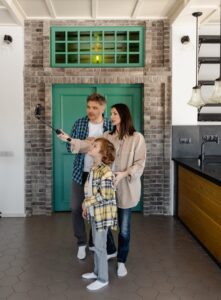 Decluttering is one of the first steps to an organized home. The emotions that emerge when sifting through items in your home can overtake your motivation to declutter. We all experience emotions when working through items acquired through our life experiences. Hope, fear, guilt and emotional attachment may prevent us from decluttering our homes. Identifying, understanding, and overcoming these emotions will help you create the peaceful home you desire.
Decluttering is one of the first steps to an organized home. The emotions that emerge when sifting through items in your home can overtake your motivation to declutter. We all experience emotions when working through items acquired through our life experiences. Hope, fear, guilt and emotional attachment may prevent us from decluttering our homes. Identifying, understanding, and overcoming these emotions will help you create the peaceful home you desire.
Here are some key areas to consider to help overcome these strong emotions.
Setting Small Goals
Have you started to declutter in the past, but the project was too overwhelming? When emotions arise, cutting the clutter can be nearly impossible to tackle. Breaking the process down in steps or a method can make the project manageable and reduce overwhelm. Instead of telling yourself you are going to organize the basement this weekend, set the goal of gathering one category of items. Getting all items together is a task that is clearly defined and does not bring on the overwhelm of the entire organizing process.
Gathering tools, pants, or pots and pans feels much more manageable than getting an entire room organized in one weekend. Once a category is gathered, set the next goal of sorting the category. Dividing the items into: need/love, don’t need/dislike, and might use/its okay categories is a task that can be completed in a reasonable time. Breaking down the individual tasks in an organizing project will help reduce overwhelm.
Letting Go
The things in our home and life arrived because of a life event. Revisiting these items may bring back memories. A college backpack, an engraved pen set, wedding dress, handwritten notes and cards, artwork, sporting goods, or tools and crafts were acquired at a time of life when there was an accomplishment, celebration, or a life change. It was a big time in your life. An array of emotions may surface when approaching these things making you feel the need to keep the items. Understand these items are not who you are. Your life experiences have shaped who you are today, not the stuff. Letting go of items will not change who you are, what you have experienced, or what you have accomplished.
Fear
The emotion of fear prevents us from decluttering our homes. We keep items because they offer a sense of security. Fear may exist because you feel you may not have the resources someday to purchase the items or the items may not be available.
The first step in overcoming this fear is understanding if you will even need or use the item someday. You may be hanging on to hobby items you will not have the time or physical ability to use again, but fear if you get rid of them, you may not have the resources to purchase them again. You may have a pantry full of expired food because you fear you may not have the resources someday to buy food. You may fear you will hurt someone if you donate the wedding gift they gave you. Understanding why you are afraid of purging the things in your home can help you overcome the fear and be realistic about what you keep in your home.
Would You Buy It Today?
Ask yourself if you would buy the item today. This question is great when you are decluttering household items, personal care items, and clothing. If you were to make a decision on whether to purchase a particular item right now, would you? Would you purchase that kitchen gadget, lipstick, or clothing item you have in your closet today? You may have truly enjoyed the item at one time. Maybe you believed the item would make you more efficient in the kitchen. If your answer to this question today is anything but “yes,” the items do not have a place in your home.
At Top Shelf Home Organizing, we love to help busy households get organized. If you are looking for guidance on getting your home organized, reach out to Jayme.
by Jayme | Jul 21, 2021 | Clutter, Organizing, Saving Time
 For many of us, getting organized is manageable but maintaining the organization is a challenge. Whether you spend your weekend binge organizing or outsource your organizing projects to a professional, the organization systems need to be maintained. As a busy mom of four, dog mom of two pooches, wife, and business owner, I want to share my 10 favorite personal tidy tips that help me keep sane when the day is hectic.
For many of us, getting organized is manageable but maintaining the organization is a challenge. Whether you spend your weekend binge organizing or outsource your organizing projects to a professional, the organization systems need to be maintained. As a busy mom of four, dog mom of two pooches, wife, and business owner, I want to share my 10 favorite personal tidy tips that help me keep sane when the day is hectic.
- Make Your Bed
Make your bed right when you crawl out.
- Put Your Stuff Away, Right Away
Remember how it takes time and resources to get organized? Now you need to put your things away to keep your home organized.
- Make the Rounds
Make the rounds through your house to collect and put away miscellaneous items daily or twice daily.
- Run the Dishwasher
Empty the dishwasher first thing in the morning. This will start your day with a clean slate in the kitchen. Load the dishwasher throughout the day with soiled dishes. Run the dishwasher nightly. Repeat this process every day to prevent a dirty dish pile-up.
- Clean-Up as You Go
Wipe the countertops after each meal. Wipe the bathroom counter and faucet after you brush your teeth. Squidgy the shower walls and door after a shower. Wipe spills and splatters as they happen.
- Have a Schedule
Have a day scheduled for larger tasks, even if you cannot dedicate a full day to these tasks. Focusing time on just one task will get it done more efficiently than juggling all the tasks unsuccessfully at one time.
-
- Grocery day
- Meal prep day
- Laundry day
- Cleaning day
- Additionally, use a deep clean schedule to help rotate through deep cleaning areas of your home. Schedule one area per week.
- Think Tidy When You Walk Through the Door
-
- Leave your shoes at the door
- Put your bag on its hook
- Keys go where they belong
- Leave Nothing on the Floor
-
- Keep toys, papers, blankets, and dirty clothes off the floor
- Hang up clothes you will re-wear right away
- Place dirty clothes go into the hamper
- Towels get hung on the hook
- Toys get put away when not being used
- Take Out the Trash
Take out the trash when you leave the house for the day. This will keep odors out of your house while you are gone. It will also feel good to see an empty garbage can when you get home from a busy day. Don’t forget garbage collection day. All trash and recycling need to go out on trash day.
- Deal with Mail Daily
Collect, sort, purge, and file mail daily. Removing the junk mail daily will make your mail opening day more manageable. File important mail in one location so it is gathered together and ready when you need to open it. Open the mail when you are ready to address, pay, and file it.
Establishing and maintaining a routine will help your home stay tidy. At Top Shelf Home Organizing, we love to help busy households get organized. If you are looking for guidance on getting your home or office organized, reach out to Jayme.

